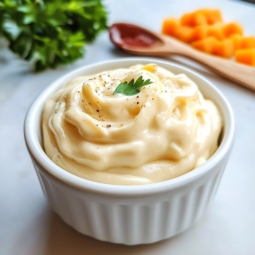Introduction to Homemade Mayonnaise
Homemade mayonnaise is a game-changer in the kitchen — silky, tangy, and bursting with fresh flavor. Unlike the store-bought versions packed with preservatives and seed oils, making mayo at home gives you full control over the ingredients. With just a few pantry staples like egg yolks, lemon juice, and neutral oil, you can whip up a creamy condiment in minutes. It’s not only healthier, but also incredibly versatile — perfect for dressings, dips, sandwiches, and more. Once you try this easy DIY mayo, you’ll never want to go back to the jarred stuff again.
What Is Mayonnaise?
Mayonnaise is a classic emulsion — a stable blend of two ingredients that don’t normally mix: oil and water-based acid (like vinegar or lemon juice), held together by an emulsifier, usually egg yolk. The result is a rich, creamy condiment with a smooth texture and mildly tangy flavor. It’s a staple in many kitchens, used as a base for salad dressings, dips, and sauces. Traditionally pale and thick, mayonnaise is made by slowly incorporating oil into the egg mixture while whisking or blending, creating that signature consistency. Its simplicity makes it endlessly adaptable for flavor variations and uses.
Why Make Homemade Mayo?
Making mayonnaise at home gives you complete control over the ingredients, taste, and texture — and once you try it, you’ll realize how superior it is to store-bought versions. First, you can choose high-quality ingredients like pasture-raised eggs and heart-healthy oils such as avocado oil or light olive oil. This means avoiding preservatives, added sugars, and inflammatory seed oils found in many commercial brands.
Homemade mayo also allows you to tweak the flavor to your liking — want it tangier, milder, or spicy? It’s totally up to you. Plus, it’s cost-effective and can be made fresh in under 5 minutes with a blender or whisk.
For those on paleo, keto, or clean-eating diets, it’s a fantastic way to stay on track without compromising taste. Whether you’re mixing up tuna salad, spreading it on sandwiches, or using it in dips, homemade mayonnaise adds flavor and freshness to every bite.
Love sauces and condiments? This homemade mayonnaise will make your dips, sandwiches, and bowls sing. Try it with this tangy Greek Chicken Marinade or pair it with crispy chicken like this Bang Bang Chicken for maximum flavor.
Basic Ingredients for Homemade Mayonnaise
The magic of homemade mayonnaise lies in its simplicity — just a few basic ingredients come together to create something creamy, tangy, and endlessly versatile. Here’s a closer look at each one:
- Eggs: The emulsifier that brings it all together. Most recipes use a whole egg or just the yolk. Pasteurized eggs are ideal if you’re concerned about food safety.
- Oil: Choose a neutral-flavored oil like avocado oil, sunflower oil, grapeseed oil, or light olive oil. Avoid extra virgin olive oil — it can taste bitter in mayo.
- Acid: Either fresh lemon juice or vinegar (white wine, apple cider, or champagne vinegar) adds tang and helps stabilize the emulsion.
- Dijon Mustard: Not just for flavor — mustard also helps with emulsification, ensuring your mayo doesn’t separate.
- Salt: Just a pinch enhances all the flavors.
Optional add-ins include a touch of honey for sweetness, garlic for depth, or herbs like dill or basil for freshness.
Tools That Help
Making homemade mayonnaise doesn’t require fancy equipment — just the right tool for the job and a steady hand. Here are your best options:
- Immersion Blender: The easiest and most foolproof method. Add all ingredients to a tall, narrow jar, submerge the blender, and blend from the bottom up. Perfect emulsification in seconds.
- Food Processor: Great for larger batches. Slowly drizzle in the oil while the blade runs to form a creamy emulsion.
- Blender: High-speed blenders work well but can sometimes over-mix or cause the mayo to separate if the oil is added too quickly.
- Whisk + Bowl: The old-school method. It requires elbow grease and patience, but it gets the job done. Place a damp towel under your bowl to stabilize it while whisking vigorously.
Choose the method that fits your kitchen style. No matter the tool, the most important part of making mayonnaise is to add the oil slowly and consistently for that perfect creamy texture.
Step-by-Step Instructions
Here’s a simple, fail-proof homemade mayonnaise recipe that yields rich, creamy results every time. It takes just a few minutes and requires minimal effort — especially with an immersion blender.
📝 Ingredients:
- 1 large egg (room temperature)
- 1 tablespoon lemon juice or white wine vinegar
- 1 teaspoon Dijon mustard
- ¼ teaspoon sea salt
- 1 cup neutral oil (like avocado, sunflower, or light olive oil)
Optional Add-ins: garlic, herbs, black pepper, a touch of honey, or a pinch of paprika.
⚙️ Method (Immersion Blender Version – Fastest & Easiest):
- Add ingredients to a jar: In a tall, narrow jar or measuring cup, add the egg, lemon juice, mustard, and salt. Pour the oil on top. Do not stir or mix yet.
- Insert the blender: Place the immersion blender at the very bottom of the jar, making sure it covers the egg. Don’t move it yet.
- Start blending: Turn the blender on and hold it at the bottom for about 10–15 seconds. You’ll see the emulsion forming instantly.
- Pull up slowly: As the mayo thickens at the bottom, slowly raise the blender to incorporate the oil on top until all ingredients are emulsified.
- Taste and adjust: Add extra lemon juice or salt to your liking and blend again briefly.

Tips for Success:
- Use room temperature ingredients for best emulsification.
- If using a food processor or whisk, drizzle oil slowly — a few drops at a time at first.
- Store in an airtight jar in the fridge for up to 1 week.
This recipe makes about 1 cup of thick, creamy homemade mayonnaise that’s perfect for dressings, sandwiches, or dipping sauces.
Pro Tip: Add roasted garlic to transform it into a creamy aioli, perfect for slathering on your next batch of Stuffed Crust Pepperoni Pizza.
Flavored Mayo Variations
One of the best parts about making homemade mayonnaise is how easy it is to customize. With just a few tweaks, you can transform basic mayo into a gourmet spread, dip, or dressing. Here are some delicious variations to try:
Savory & Bold
- Garlic Aioli: Add 1–2 cloves of roasted garlic for a mellow, rich flavor.
- Sriracha Mayo: Stir in 1 tablespoon of Sriracha or your favorite hot sauce for heat and tang.
- Herb Mayo: Blend in finely chopped fresh herbs like dill, basil, or parsley for a green, garden-fresh taste.
- Smoked Paprika Mayo: Add ½ teaspoon of smoked paprika for a subtle smoky kick.
Light & Bright
- Lemon Basil Mayo: Use lemon juice and fresh basil for a zesty, fragrant option.
- Curry Mayo: Stir in ½ teaspoon of curry powder and a touch of honey for a unique twist.
Health-Conscious Swaps
- Vegan Mayo: Replace the egg with aquafaba (chickpea water) and follow the same blending method.
- Greek Yogurt Blend: Mix half mayo, half Greek yogurt for a lighter, protein-rich spread.
These variations are perfect for sandwiches, wraps, dipping sauces, and dressings. Once you master the base, the possibilities are endless!
Make a batch and use it with this Tater Tot Breakfast Bowl for a creamy finishing touch.
Common Issues & Fixes
- Too thin? Slowly blend in more oil.
- Too thick? Add a splash of water or lemon juice.
- Broken emulsion? Add a fresh yolk and reblend.
How to Store It
Once you’ve made your homemade mayonnaise, proper storage is key to maintaining its freshness and safety. Transfer it to a clean, airtight glass jar or container immediately after making. Store it in the coldest part of your refrigerator, not in the door, to ensure a consistent temperature.
Homemade mayo typically lasts up to 7 days, though some versions may keep for up to 2 weeks if made with pasteurized eggs and handled hygienically. Always use a clean spoon to scoop it — never double dip.
If it smells off, changes color, or separates excessively, it’s time to toss it.

Homemade Mayonnaise
Ingredients
- 1 large egg room temperature
- 1 cup neutral oil e.g., avocado, sunflower, or light olive oil
- 1 tablespoon lemon juice or white wine vinegar
- 1 teaspoon Dijon mustard
- ¼ teaspoon sea salt
Instructions
- In a tall jar, combine egg, lemon juice, mustard, and salt.
- Pour oil on top—do not stir.
- Place immersion blender at the bottom of the jar.
- Blend on low, keeping the blender still for 10–15 seconds, then slowly lift to incorporate oil.
- Taste and adjust seasoning if needed.
- Store in an airtight container in the fridge.
Notes
- Use pasteurized eggs for food safety.
- Add garlic, herbs, or hot sauce for flavor variations.
- If mayo breaks, add a new egg yolk to a bowl and slowly whisk in the broken mixture.
Great Dishes to Pair With Homemade Mayo
- Chicken salad, egg salad, tuna salad
- Crab cakes or fish tacos
- Sandwiches and wraps
- Potato or pasta salads like this Creamy Ranch Taco Pasta Salad
Frequently Asked Questions About homemade mayonnaise
Is homemade mayonnaise safe to eat?
Yes — as long as you use fresh, high-quality eggs. For added safety, use pasteurized eggs or pasteurize them at home. Keeping your mayo refrigerated and using clean utensils will also help prevent contamination.
Why does my homemade mayonnaise taste bitter?
This often happens when using extra virgin olive oil, which can have a strong, sometimes bitter flavor. To avoid this, use light olive oil or neutral oils like avocado, sunflower, or canola.
How do you thicken homemade mayonnaise?
If your mayo is too thin, slowly blend in more oil. Make sure the oil is added gradually to maintain proper emulsification. Using room-temperature ingredients also helps achieve the ideal thickness.
Can you make mayonnaise without mustard?
Yes, but it helps with emulsification. If omitting mustard, be extra careful when blending — the mayo will be more prone to breaking. You can also substitute it with a touch of vinegar or a second egg yolk.
How long does homemade mayo last in the fridge?
Typically 7–10 days when stored in a clean, airtight container in the refrigerator. Always check for off smells or separation before using.
Can I use olive oil in homemade mayo?
Yes, but go with light olive oil for a milder flavor. Strong, peppery oils can overpower the mayo.
How to Pasteurize Eggs at Home ?
Final Thoughts
Homemade mayonnaise is the ultimate kitchen hack for anyone who loves bold flavor and fresh ingredients. Once you taste your first batch, you’ll wonder why you didn’t start sooner.
It’s also a great base for other recipes—whether you’re cooking up Baja Fish Tacos or spreading it on your next burger creation.



